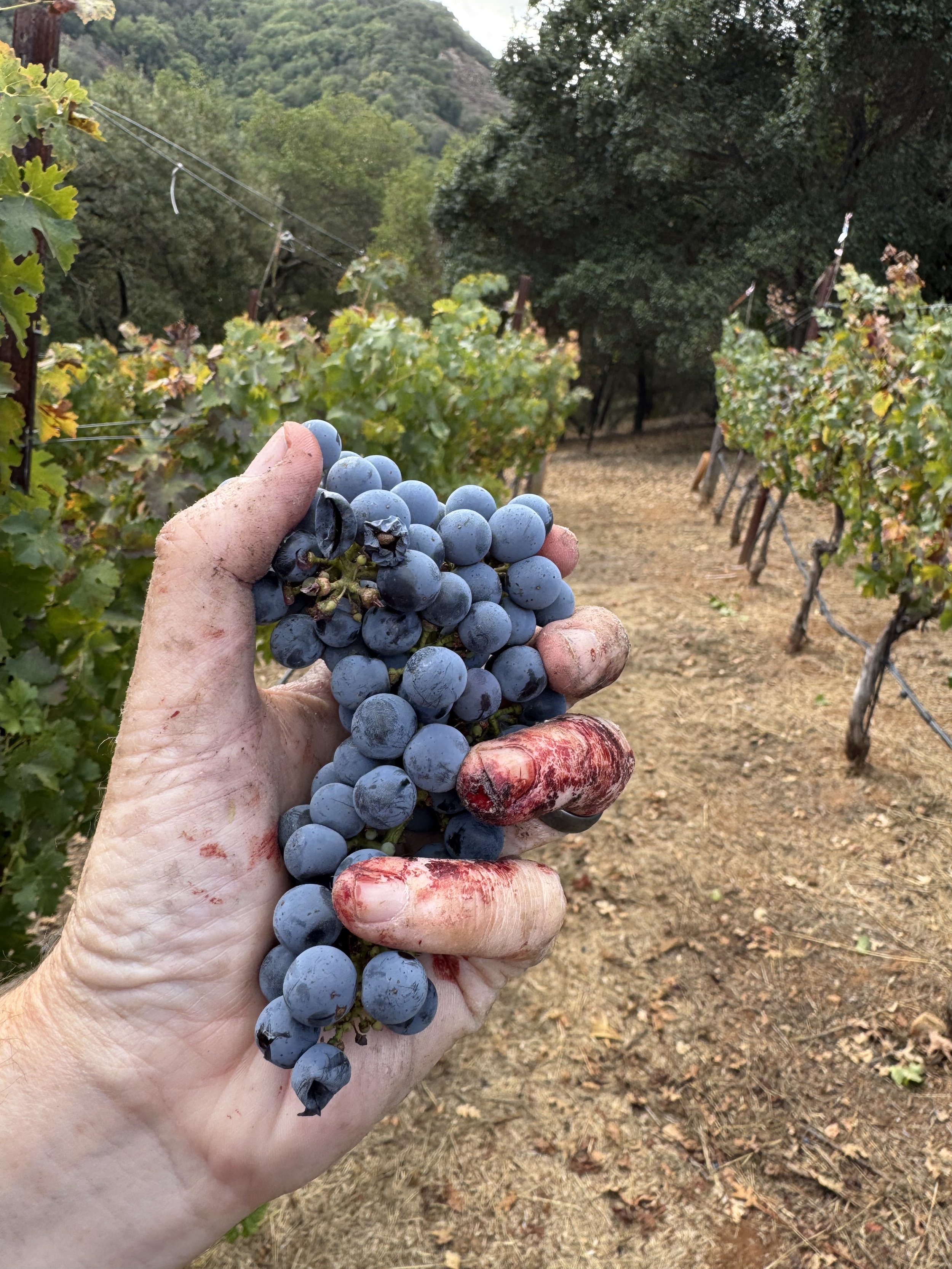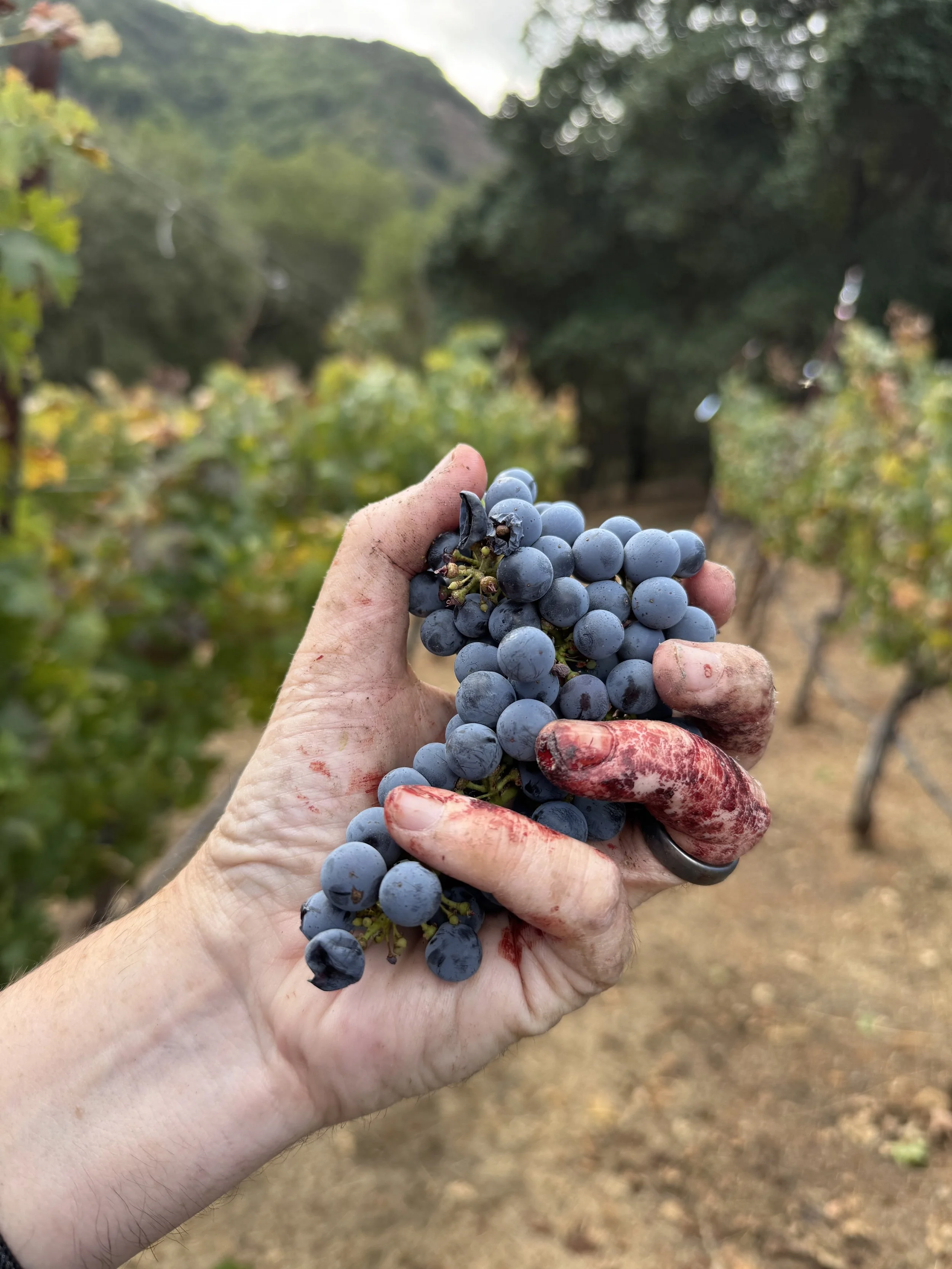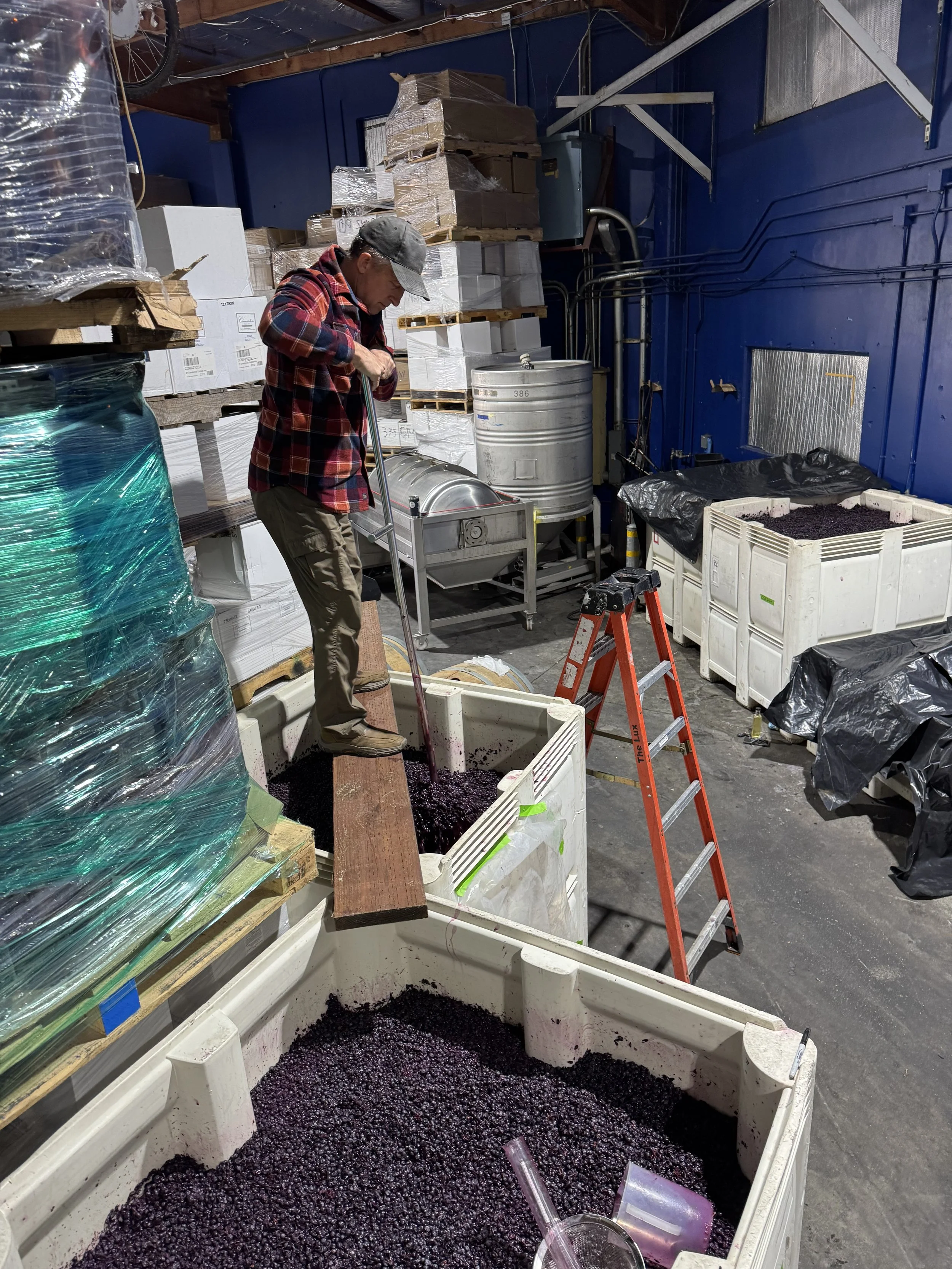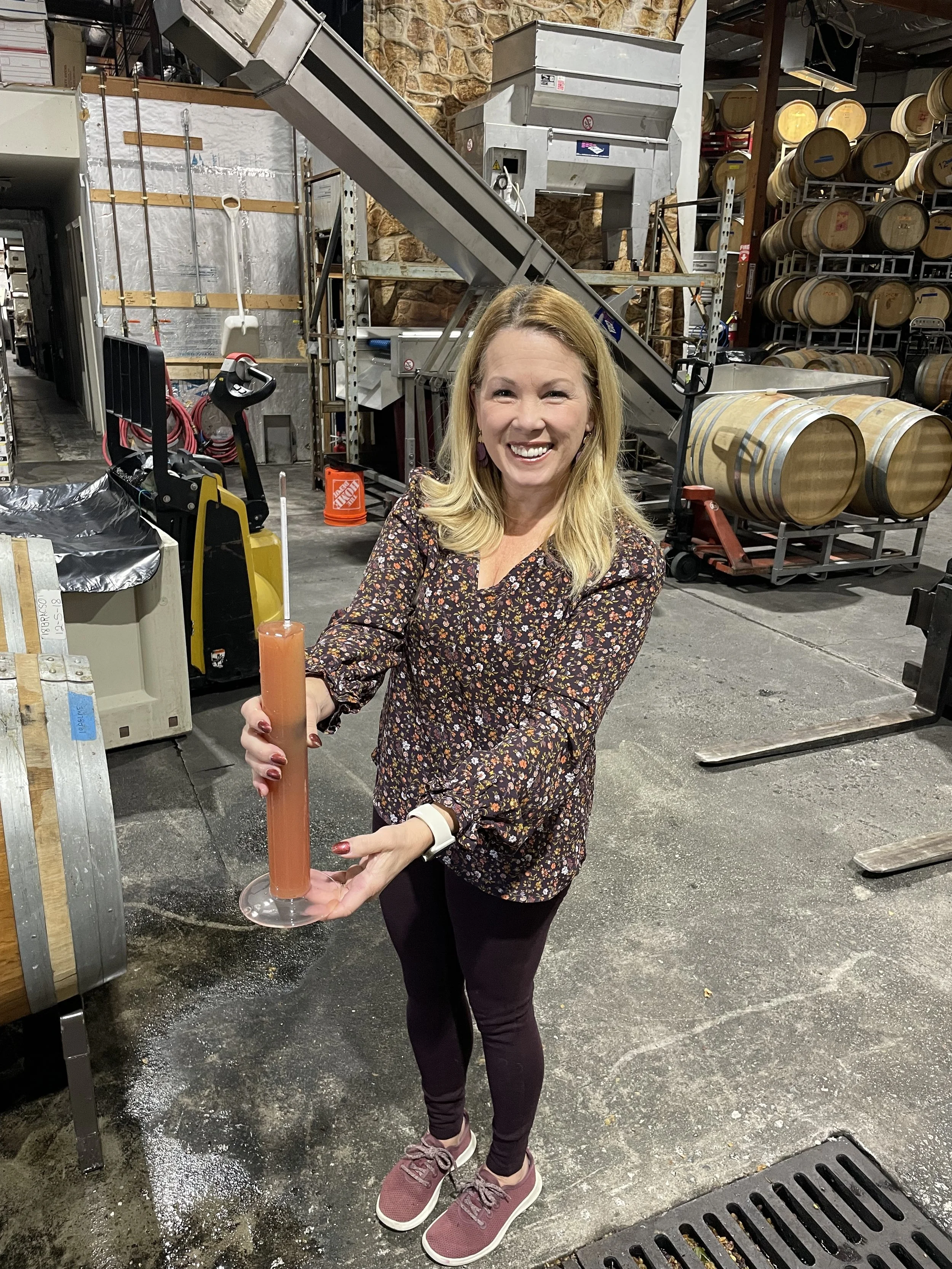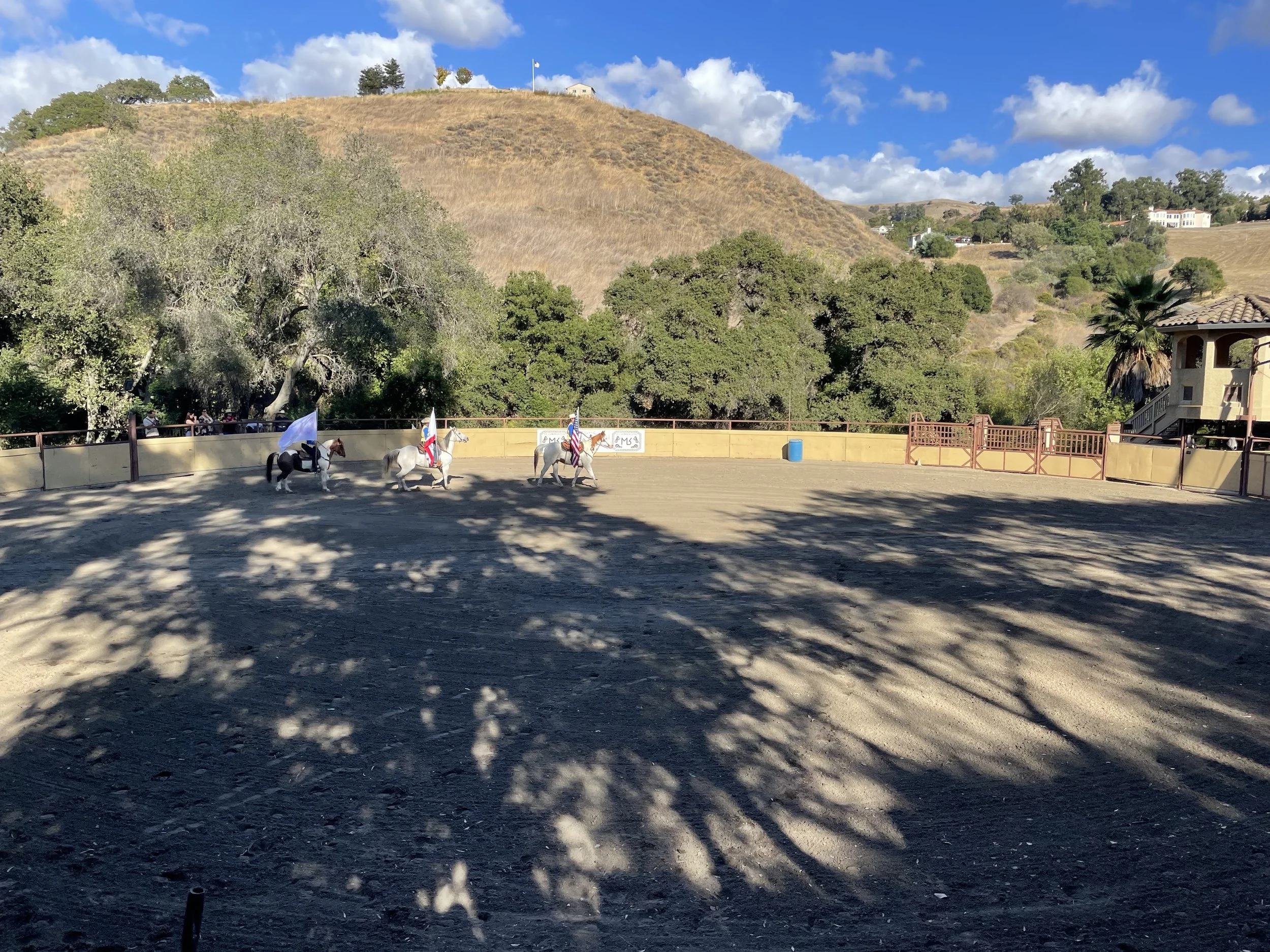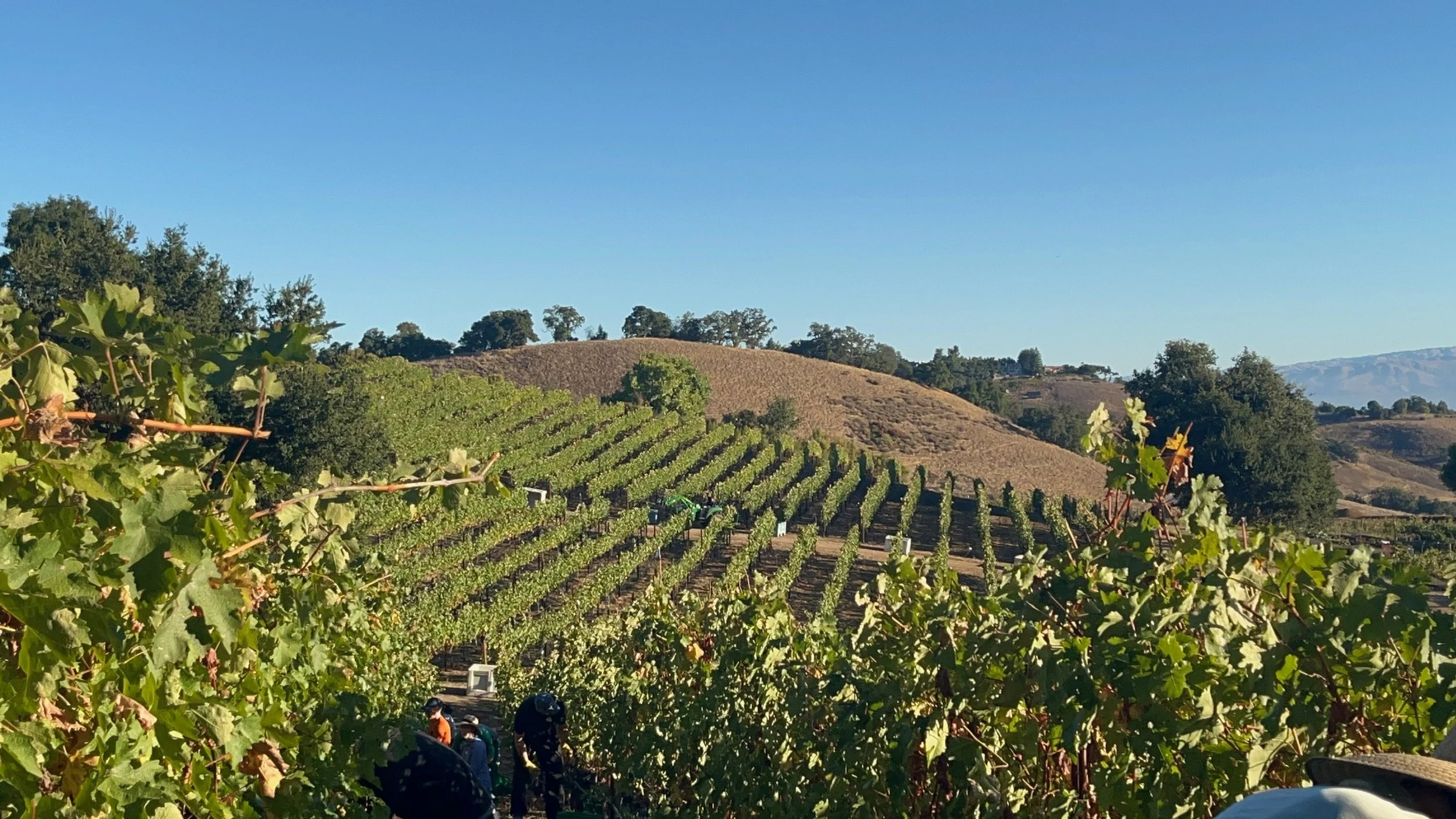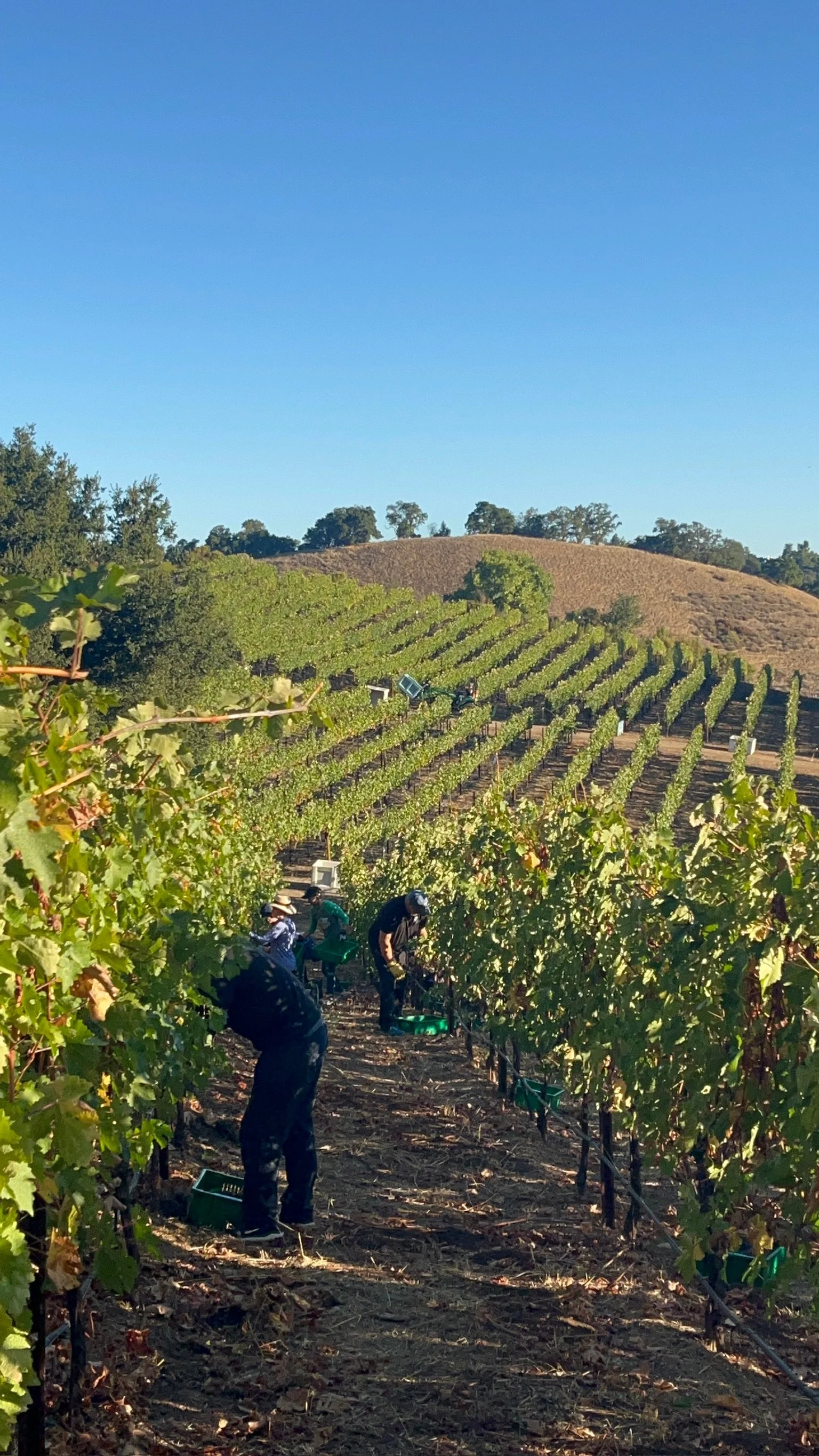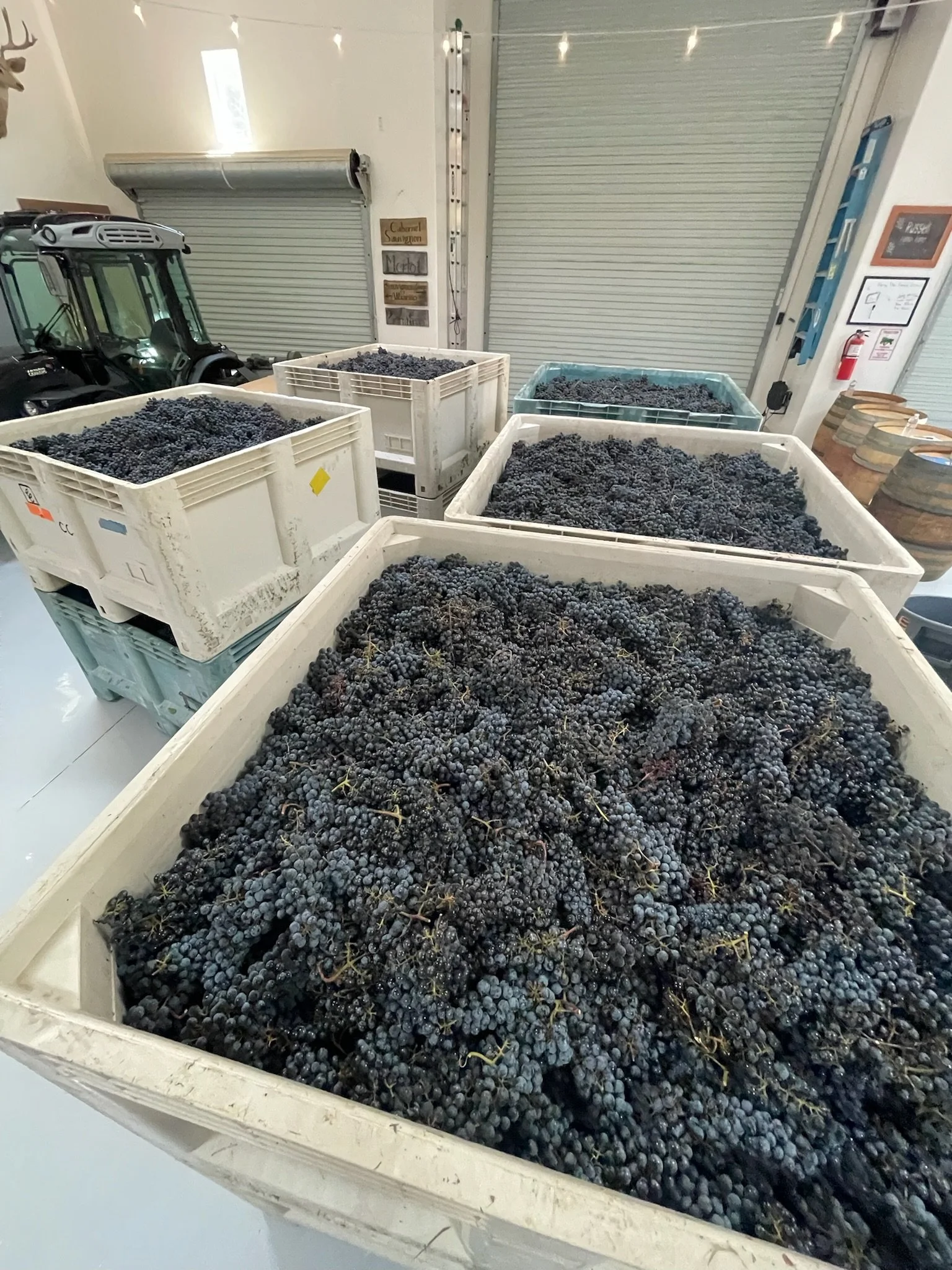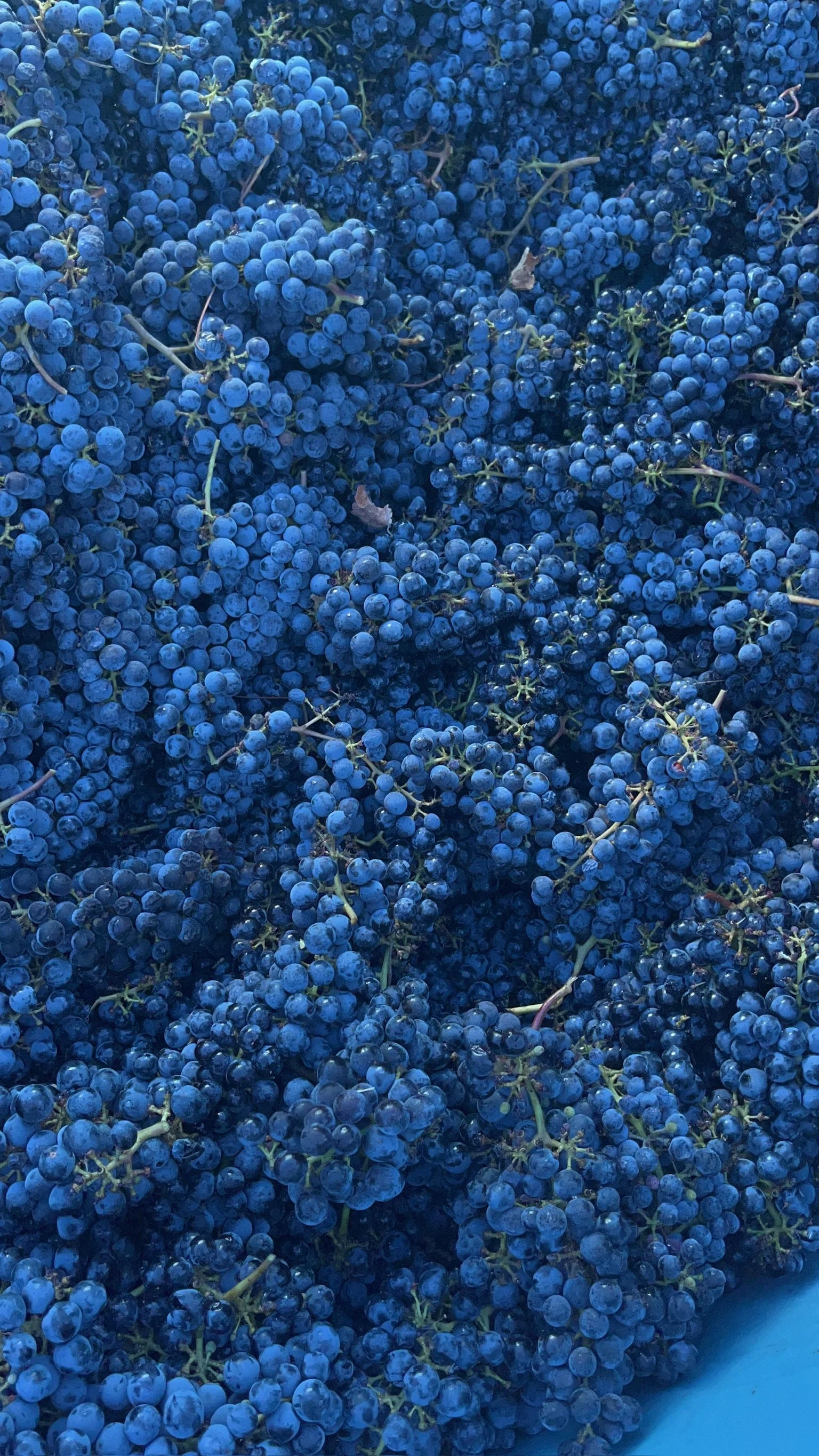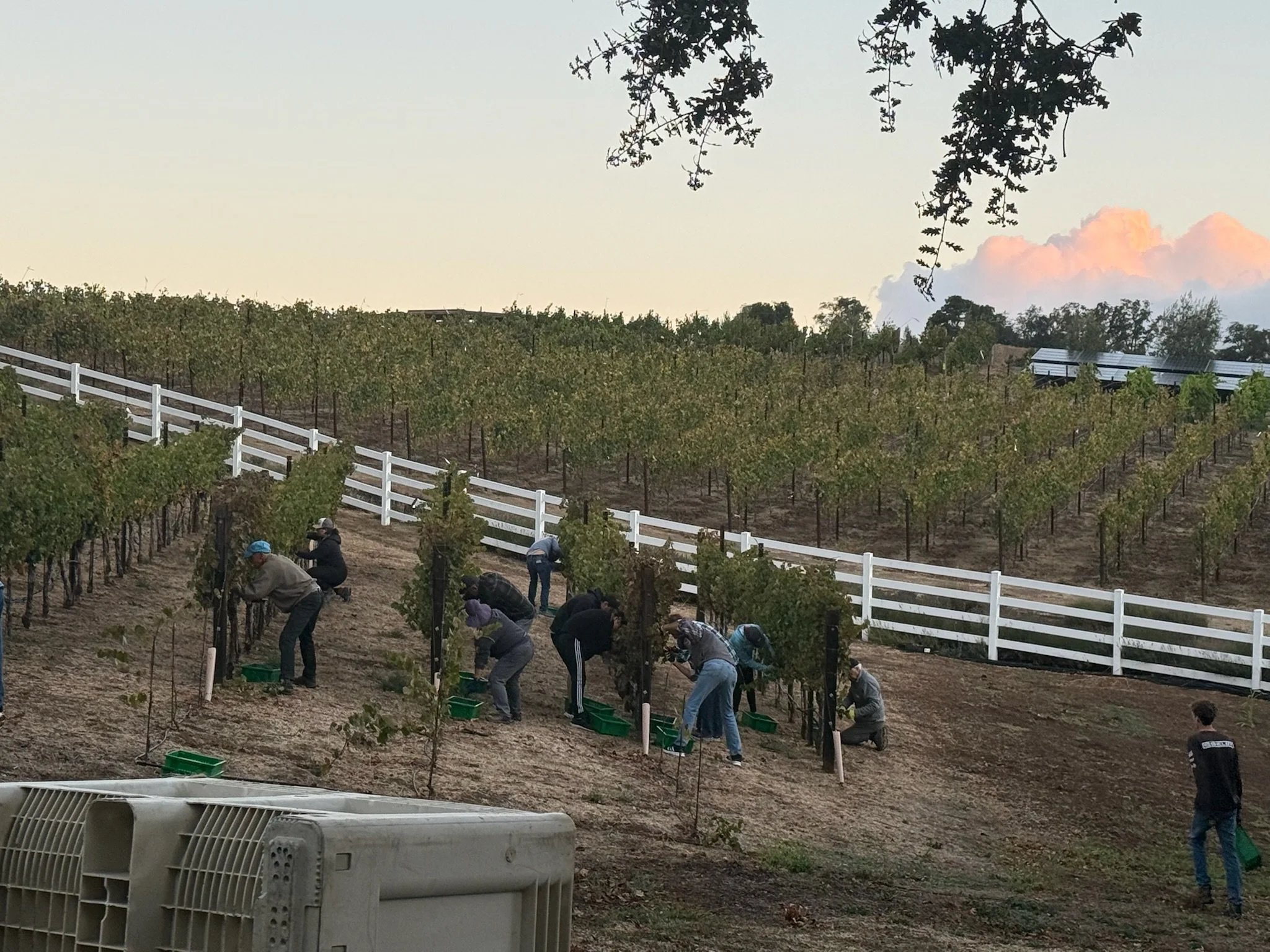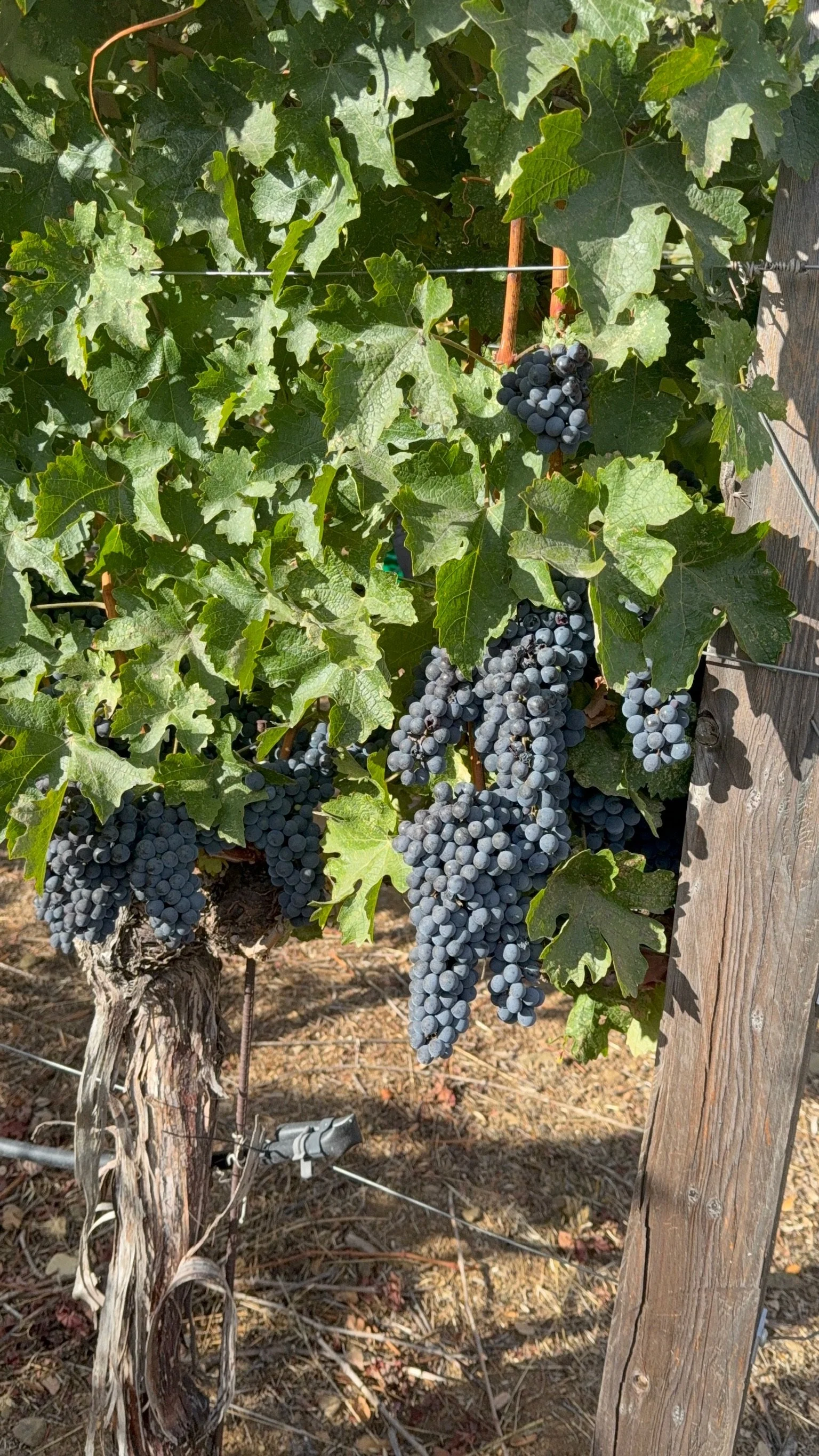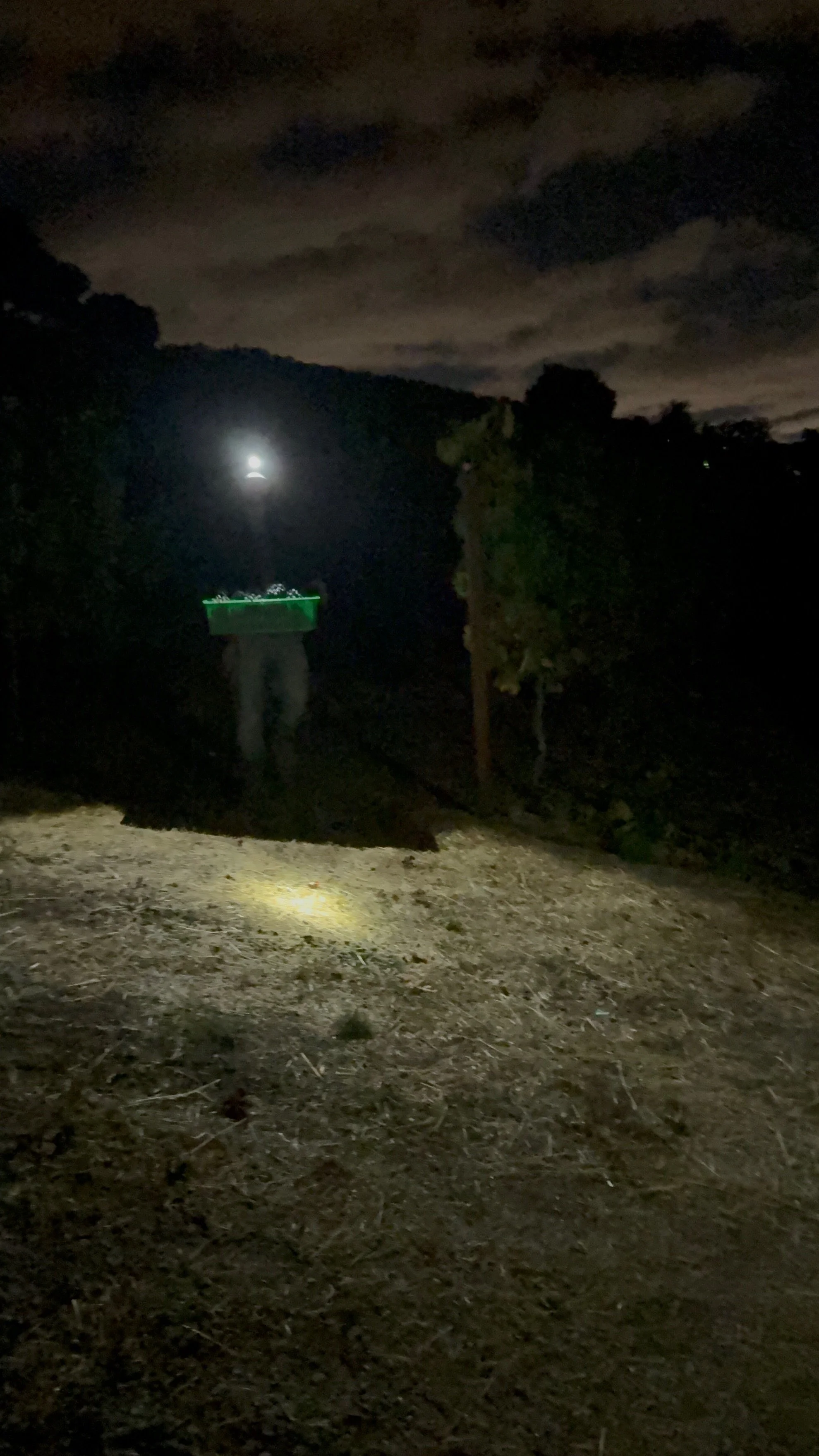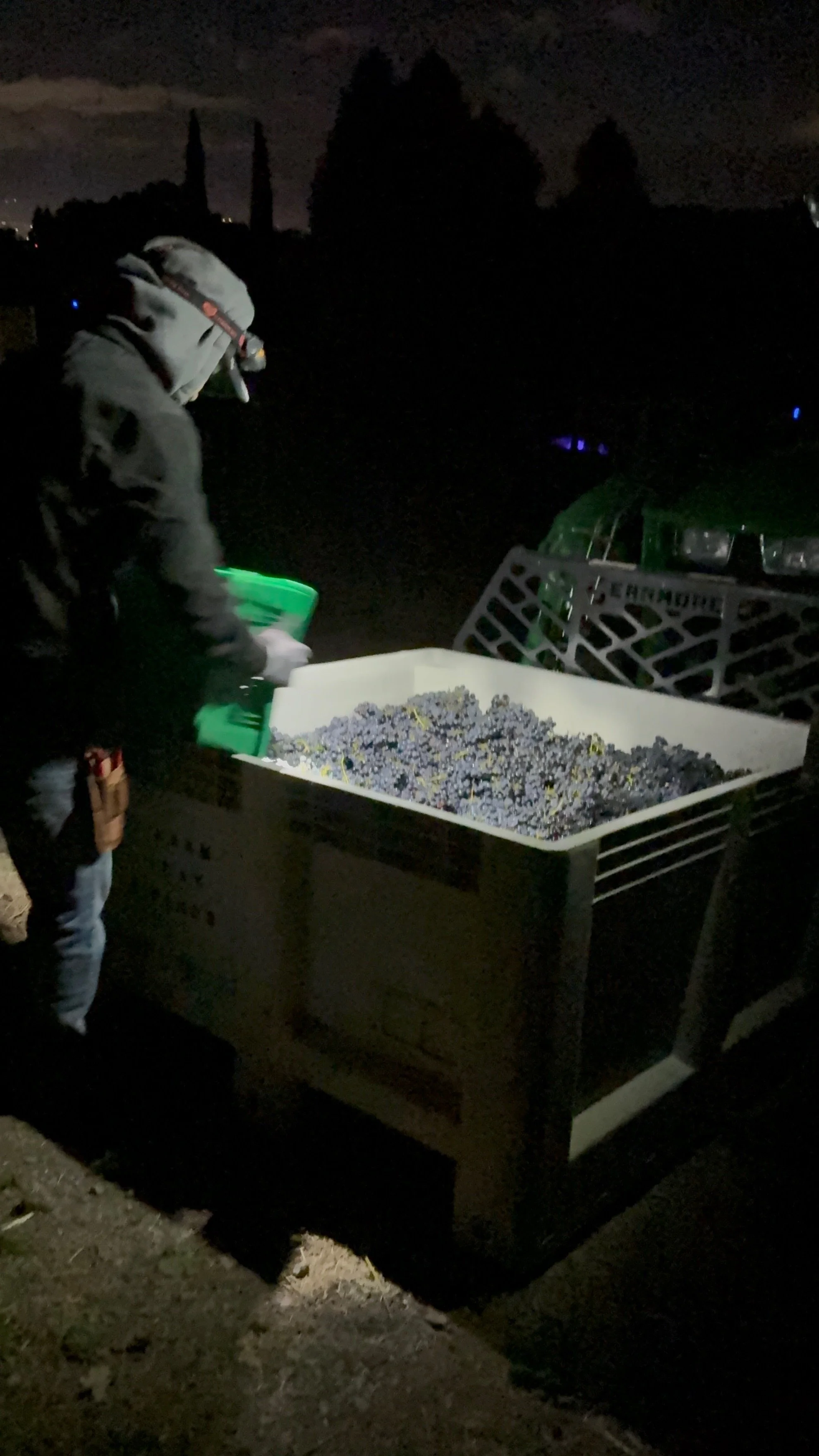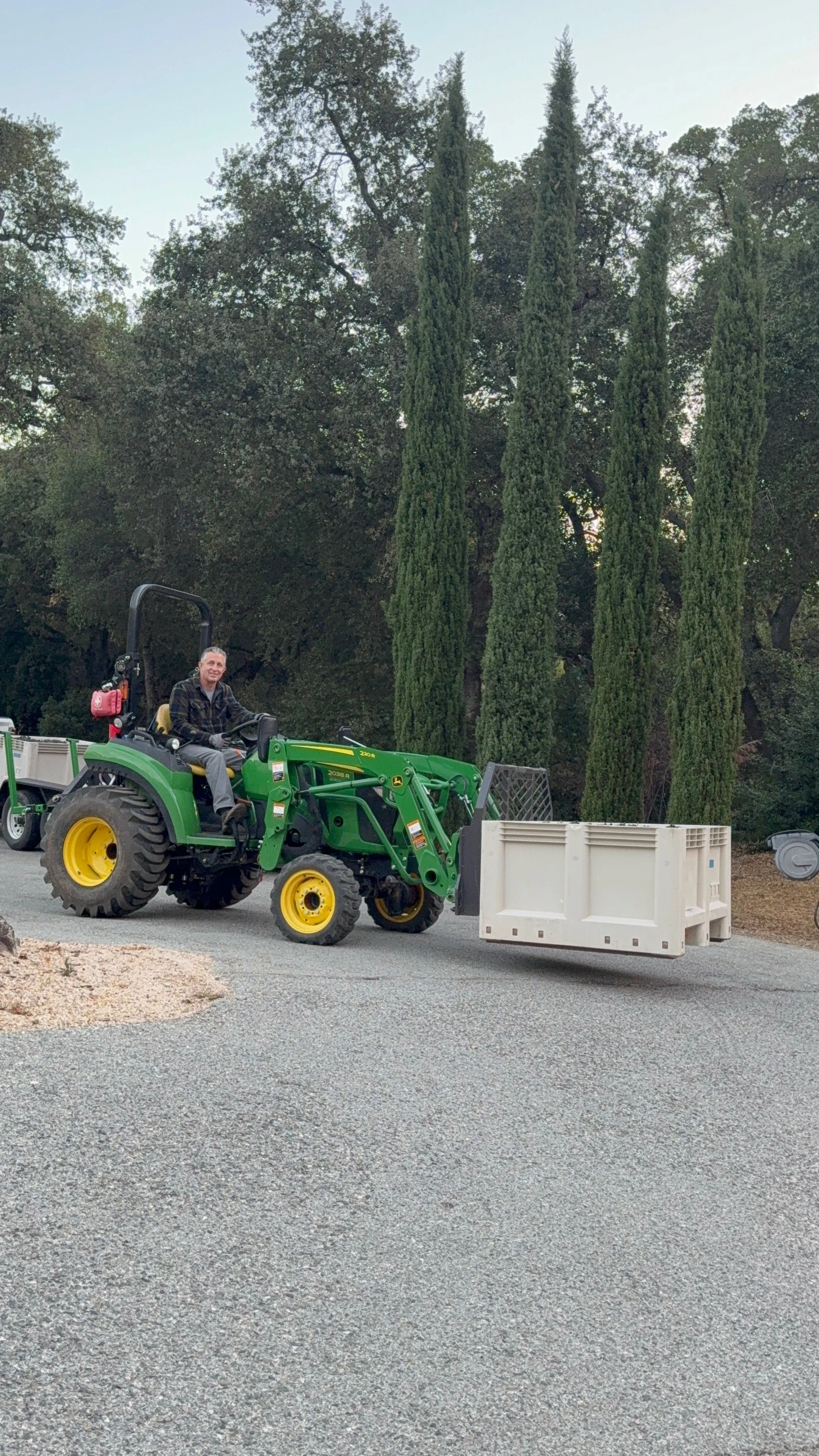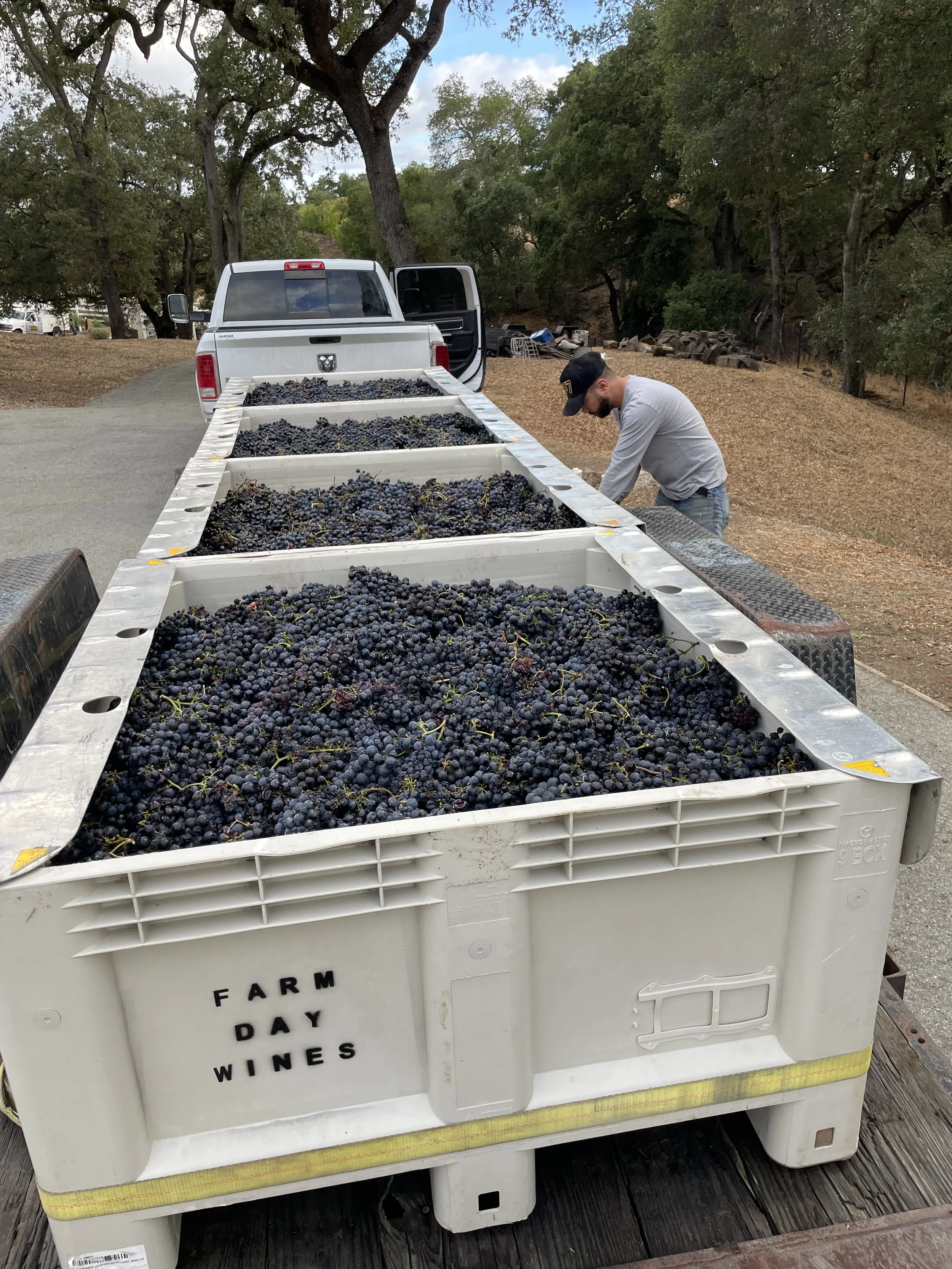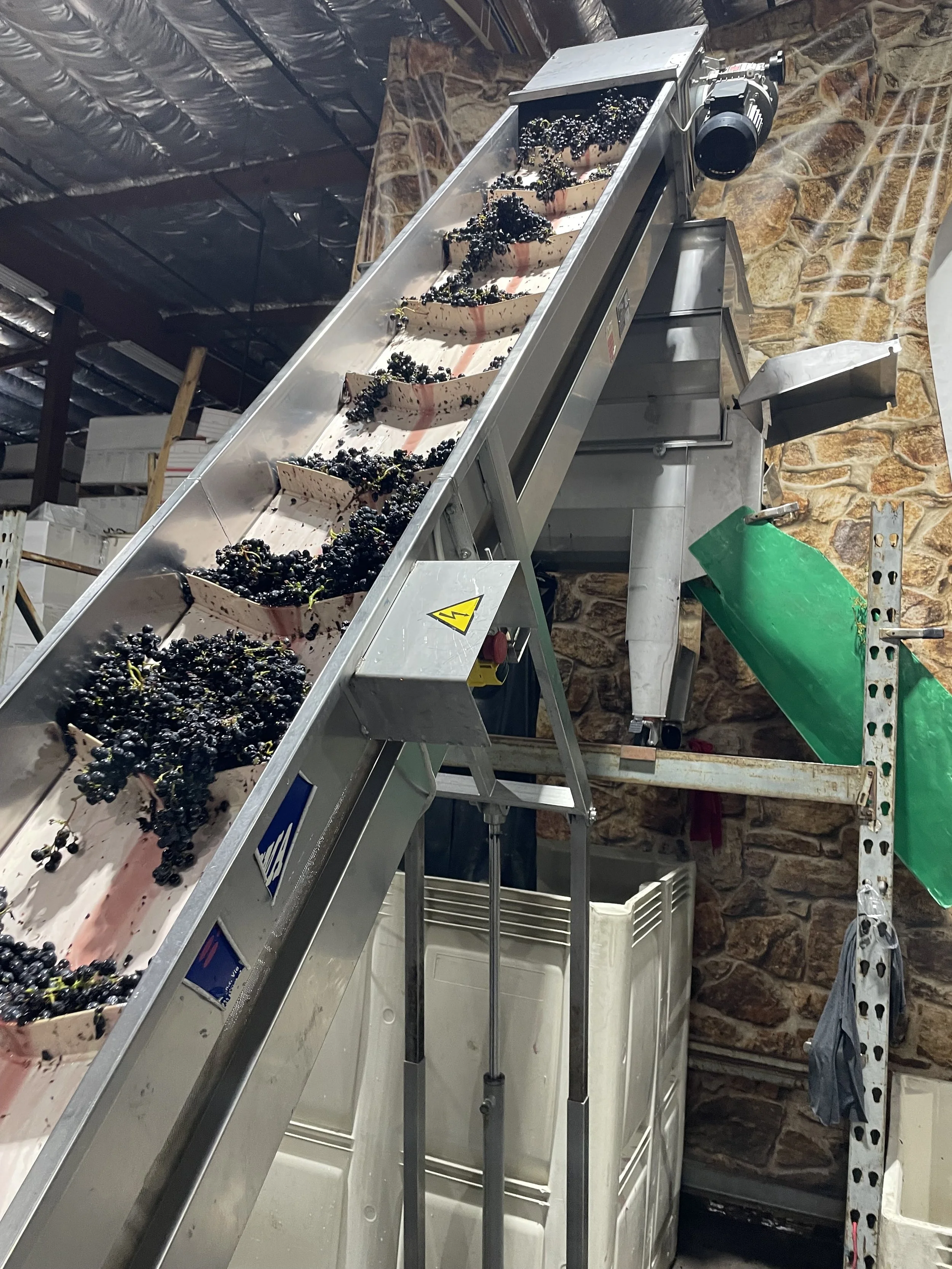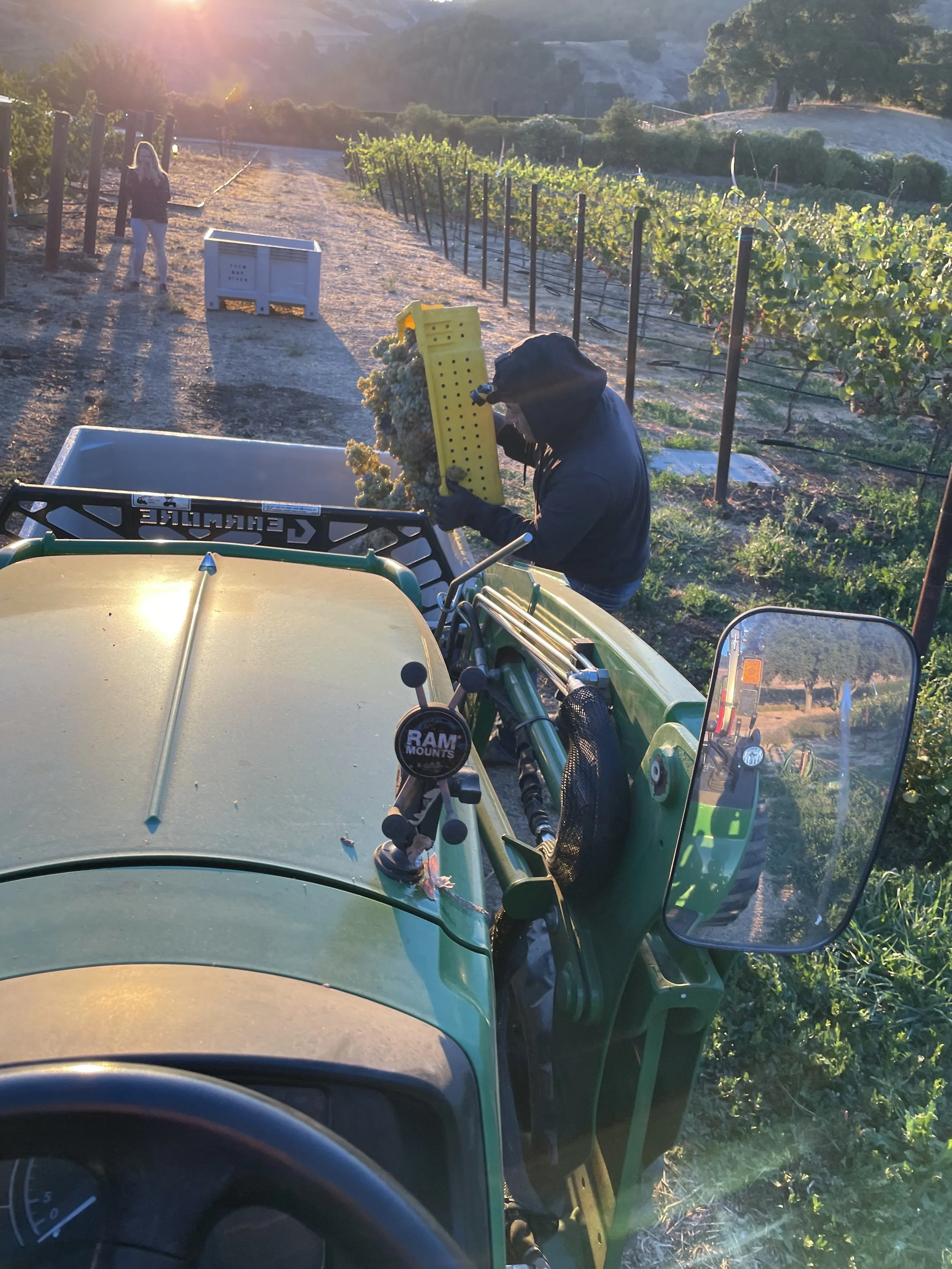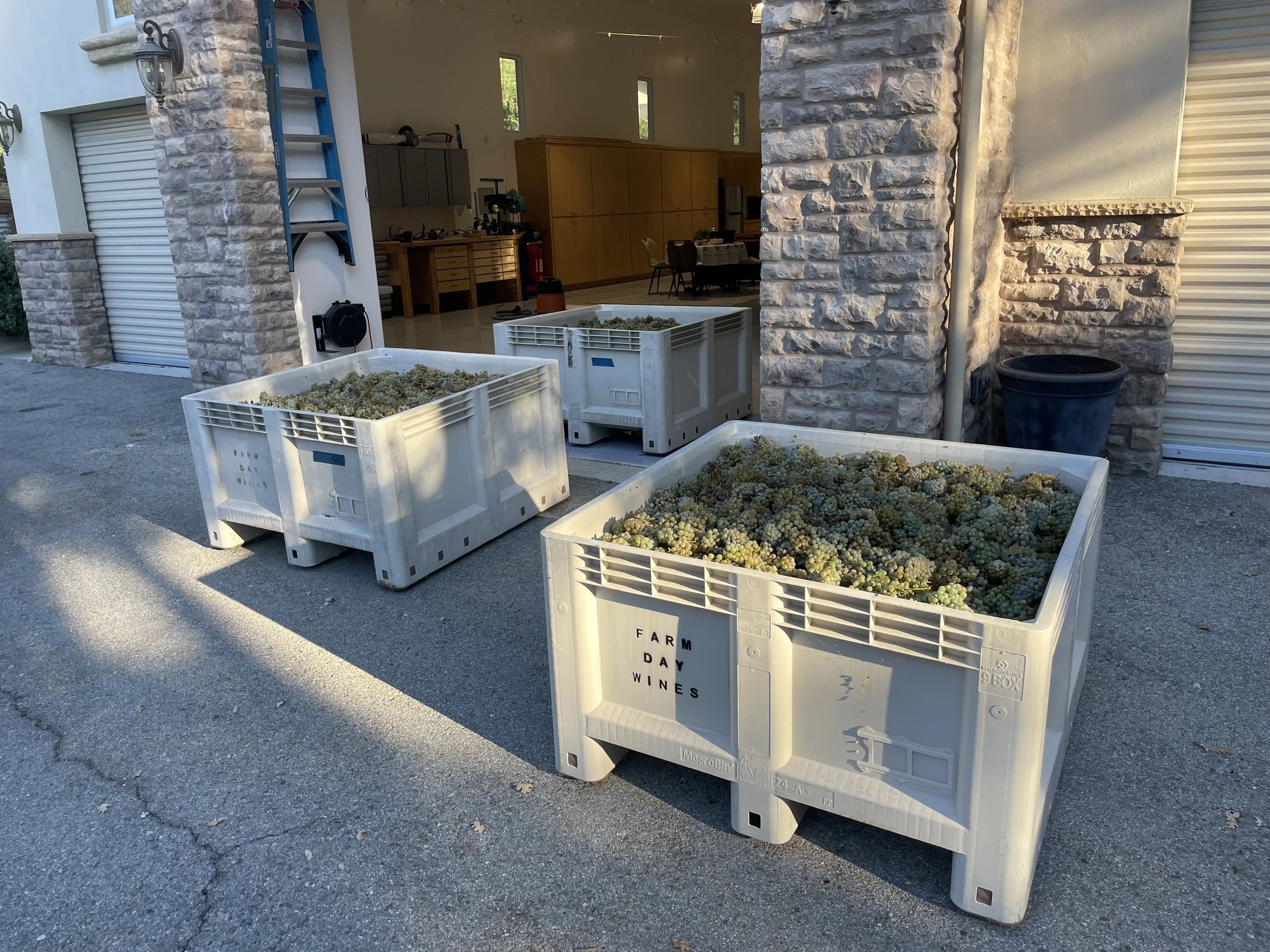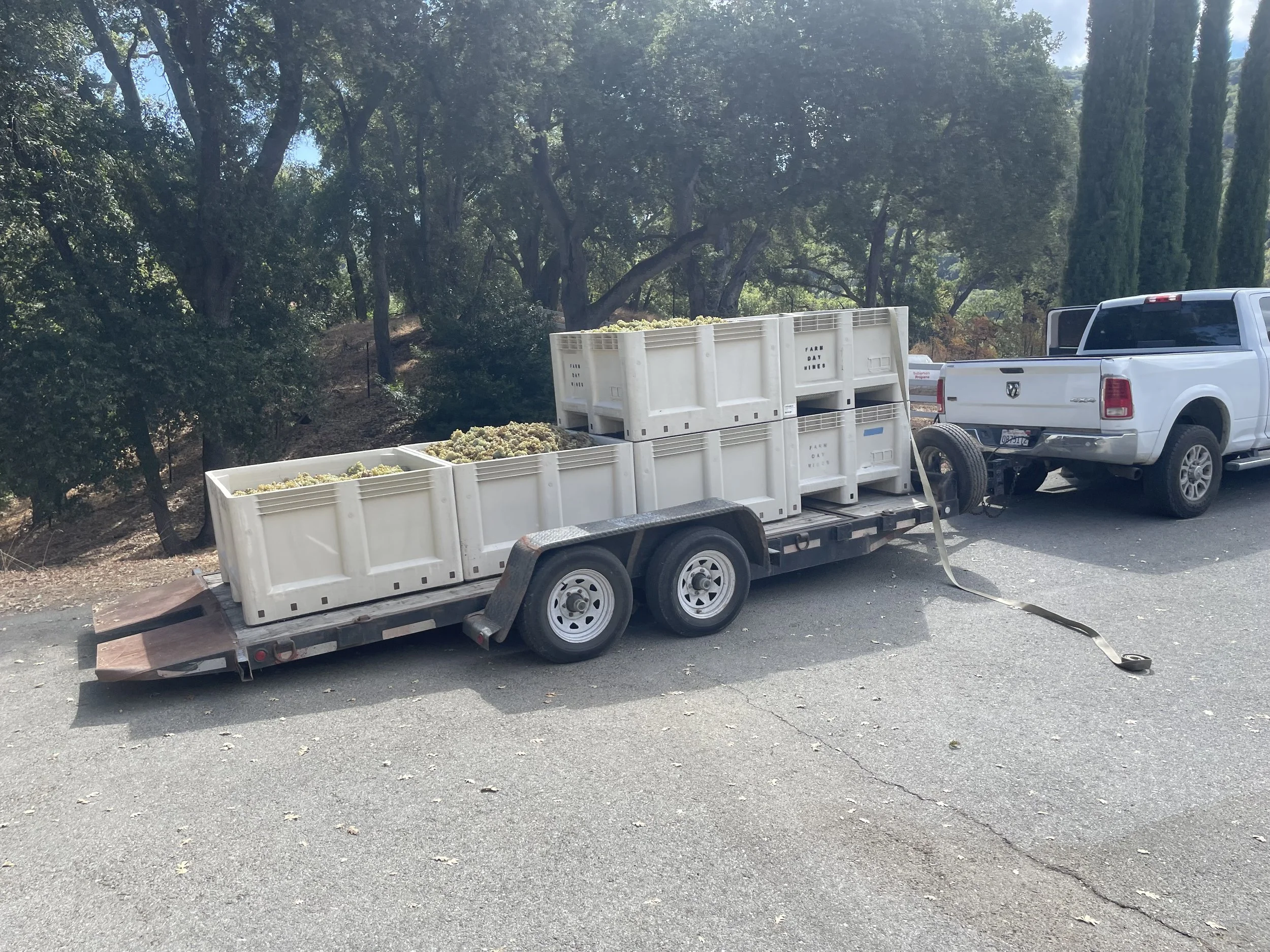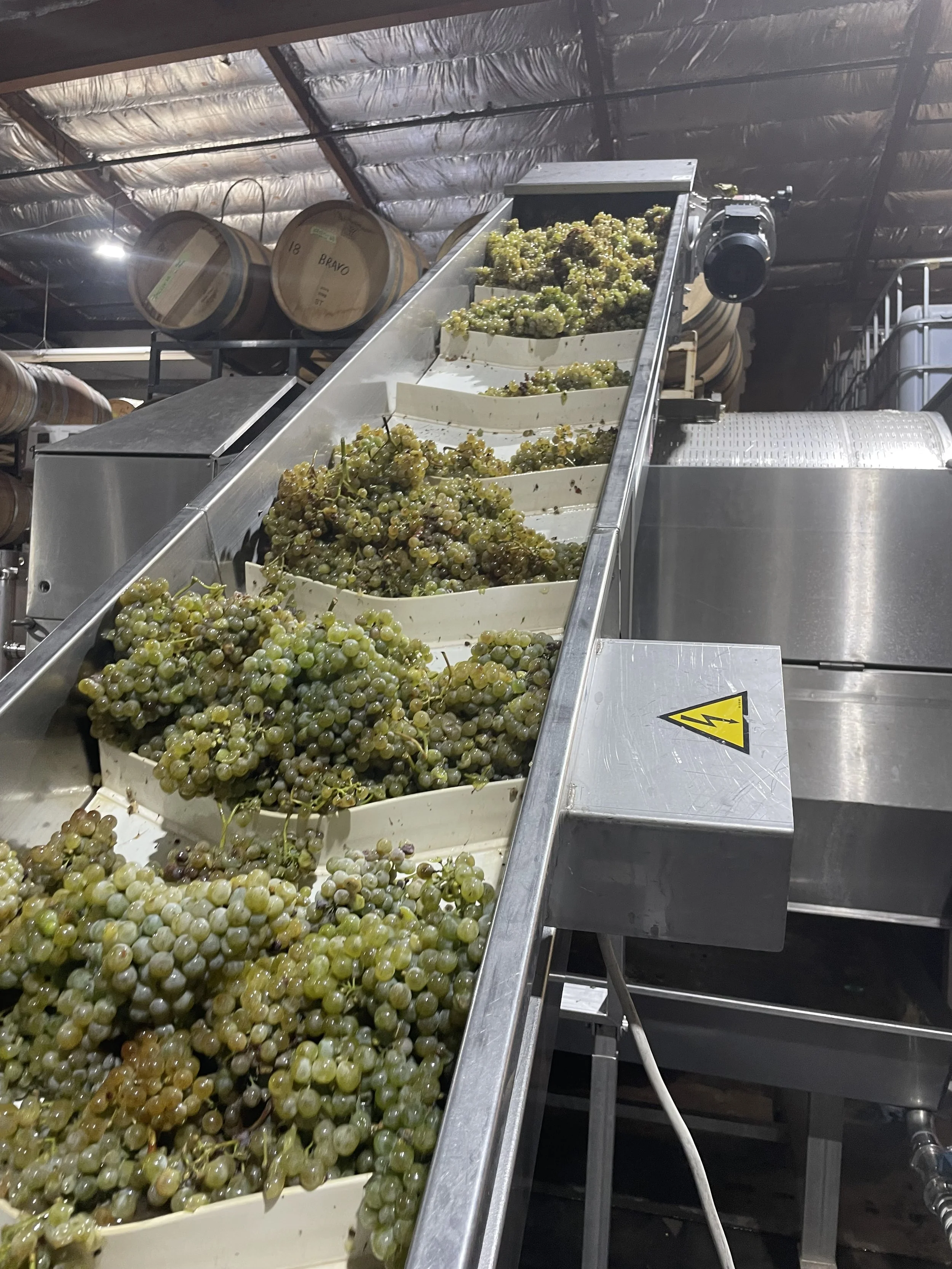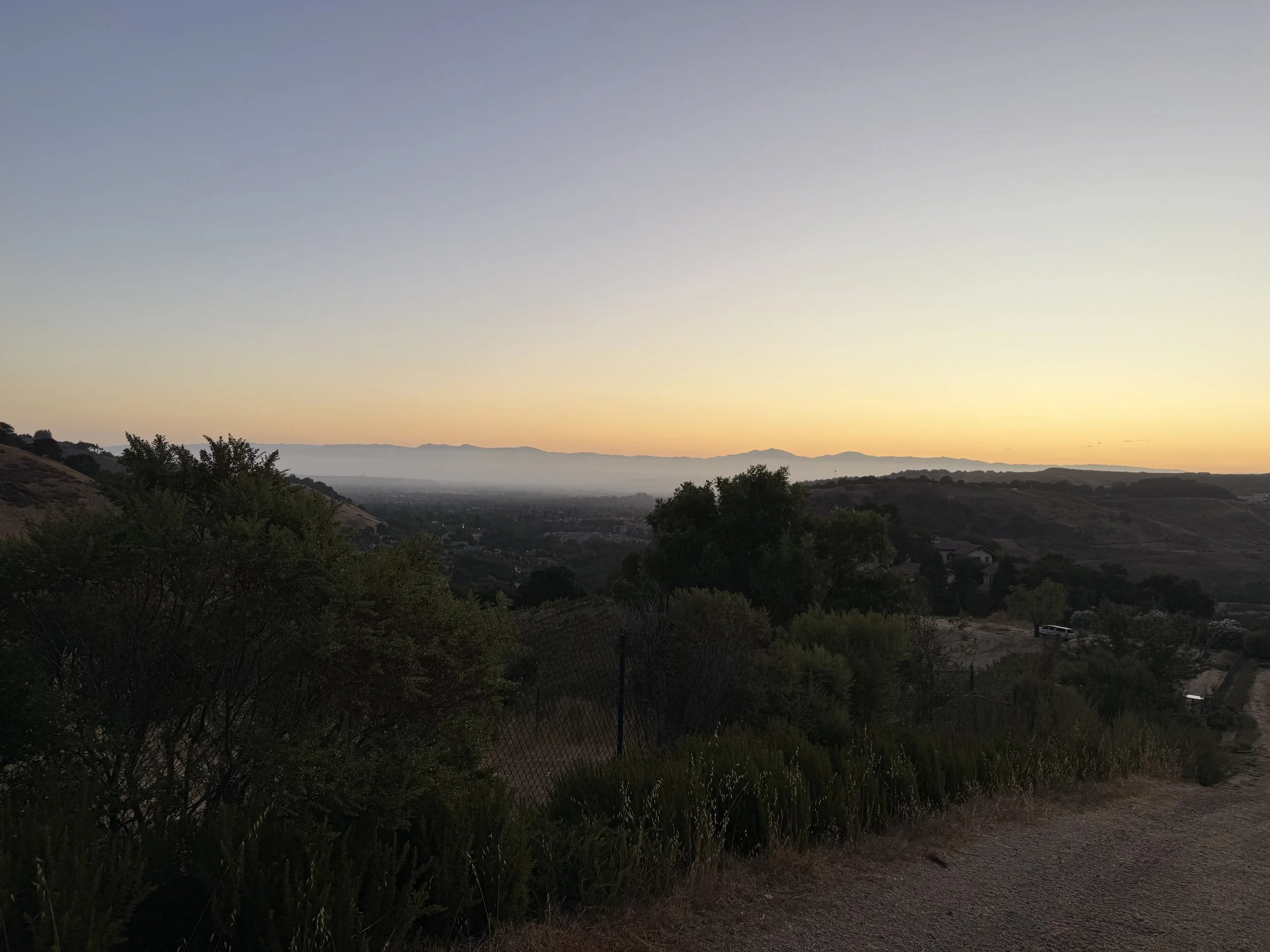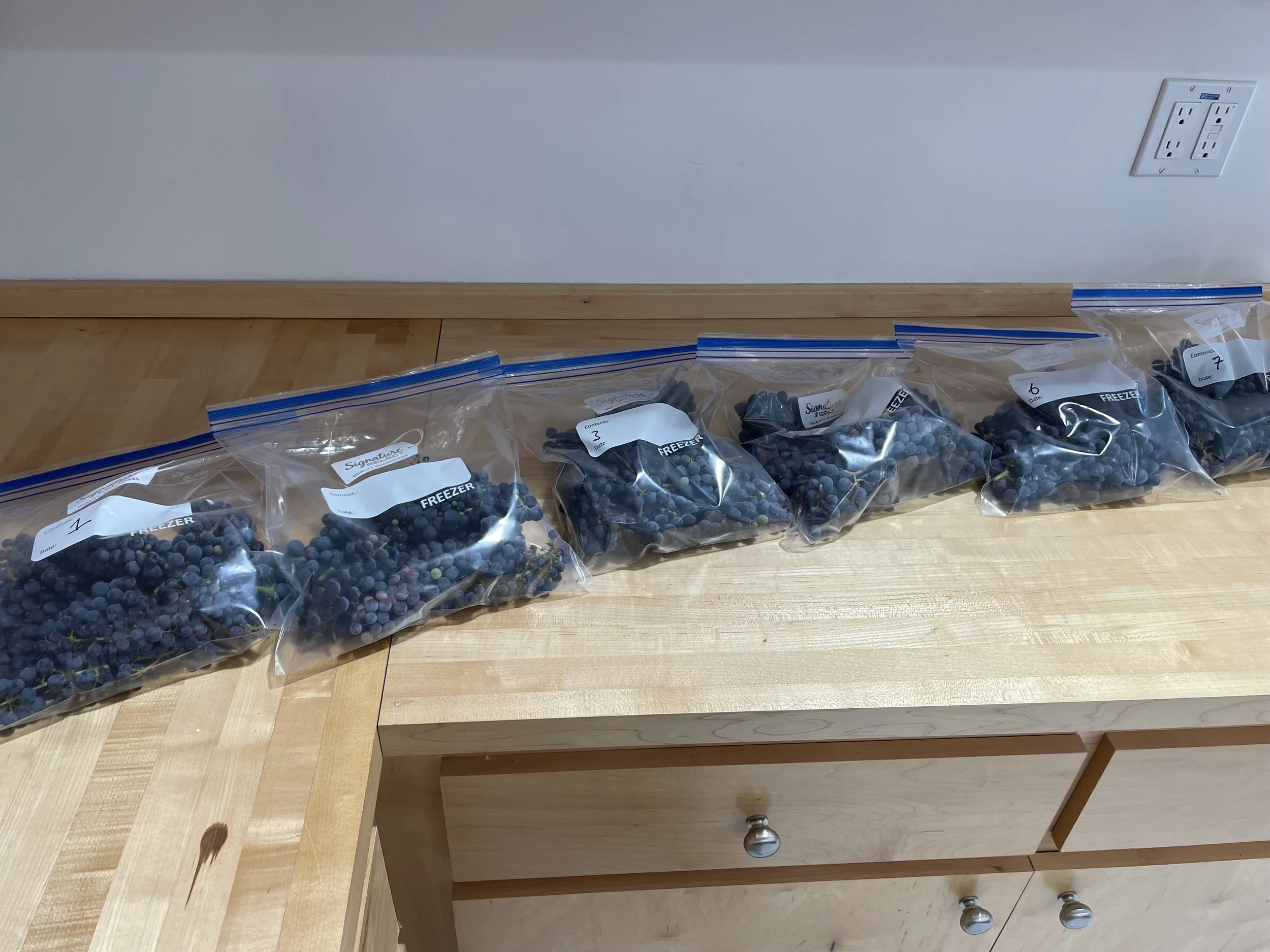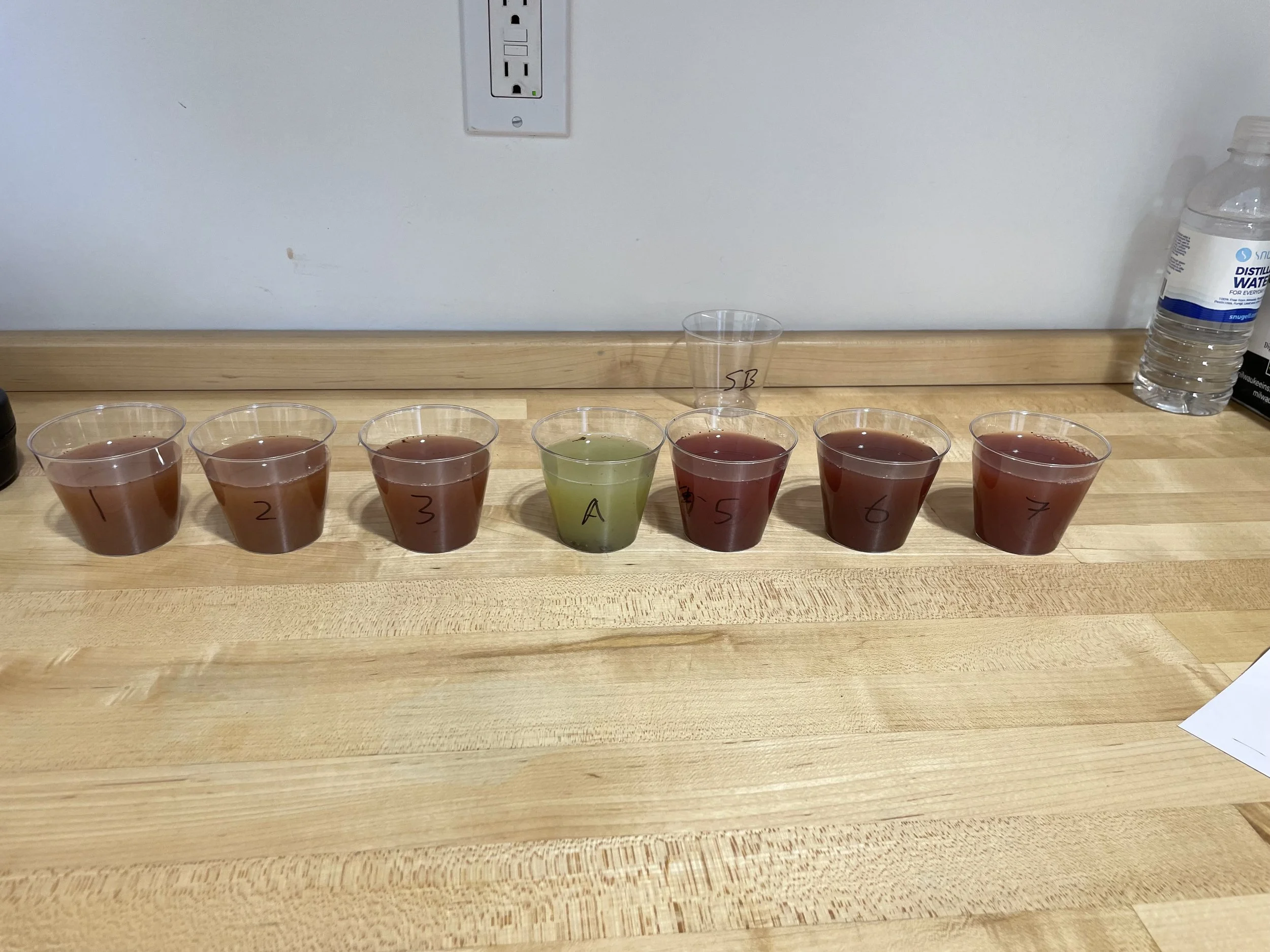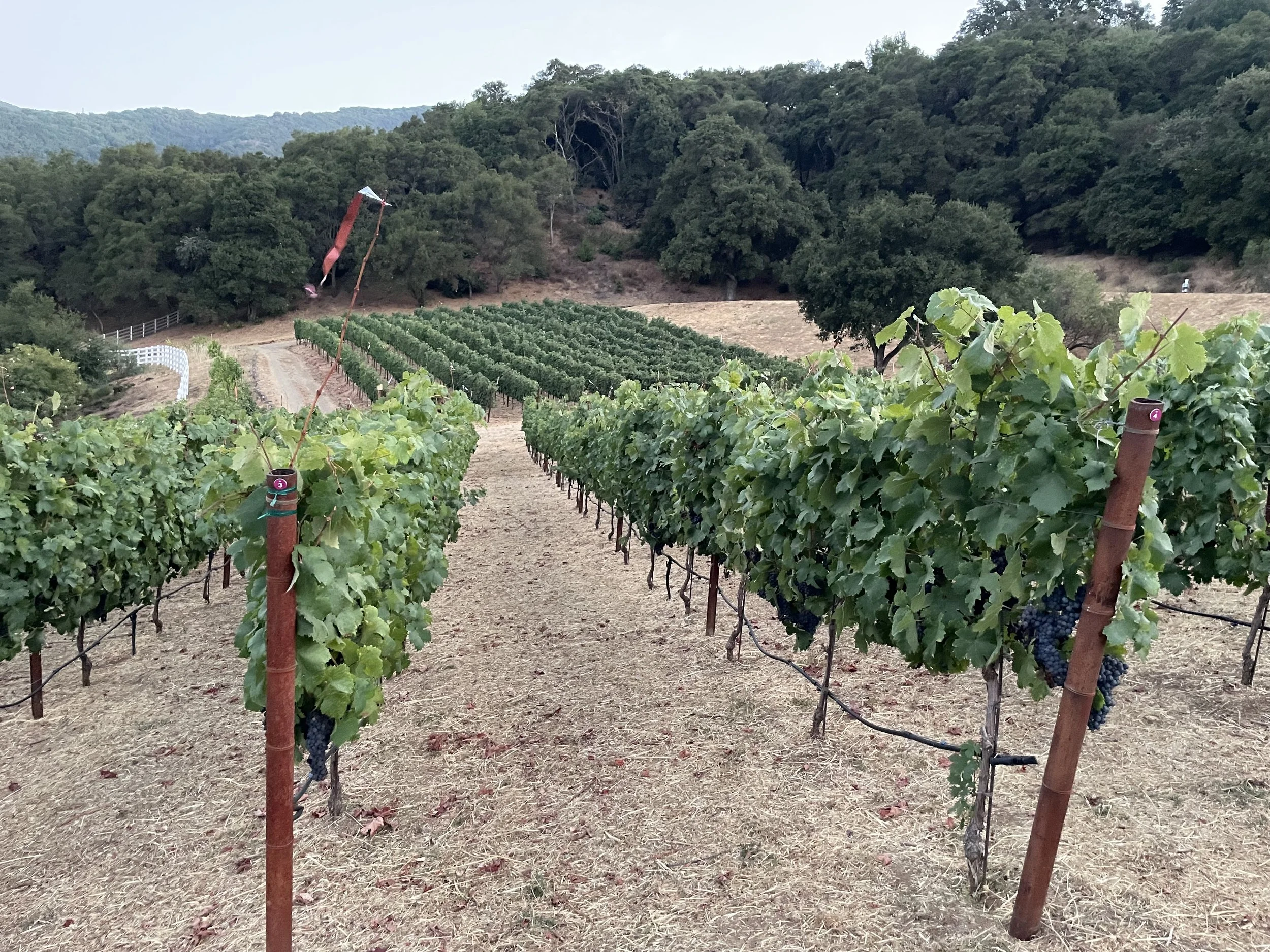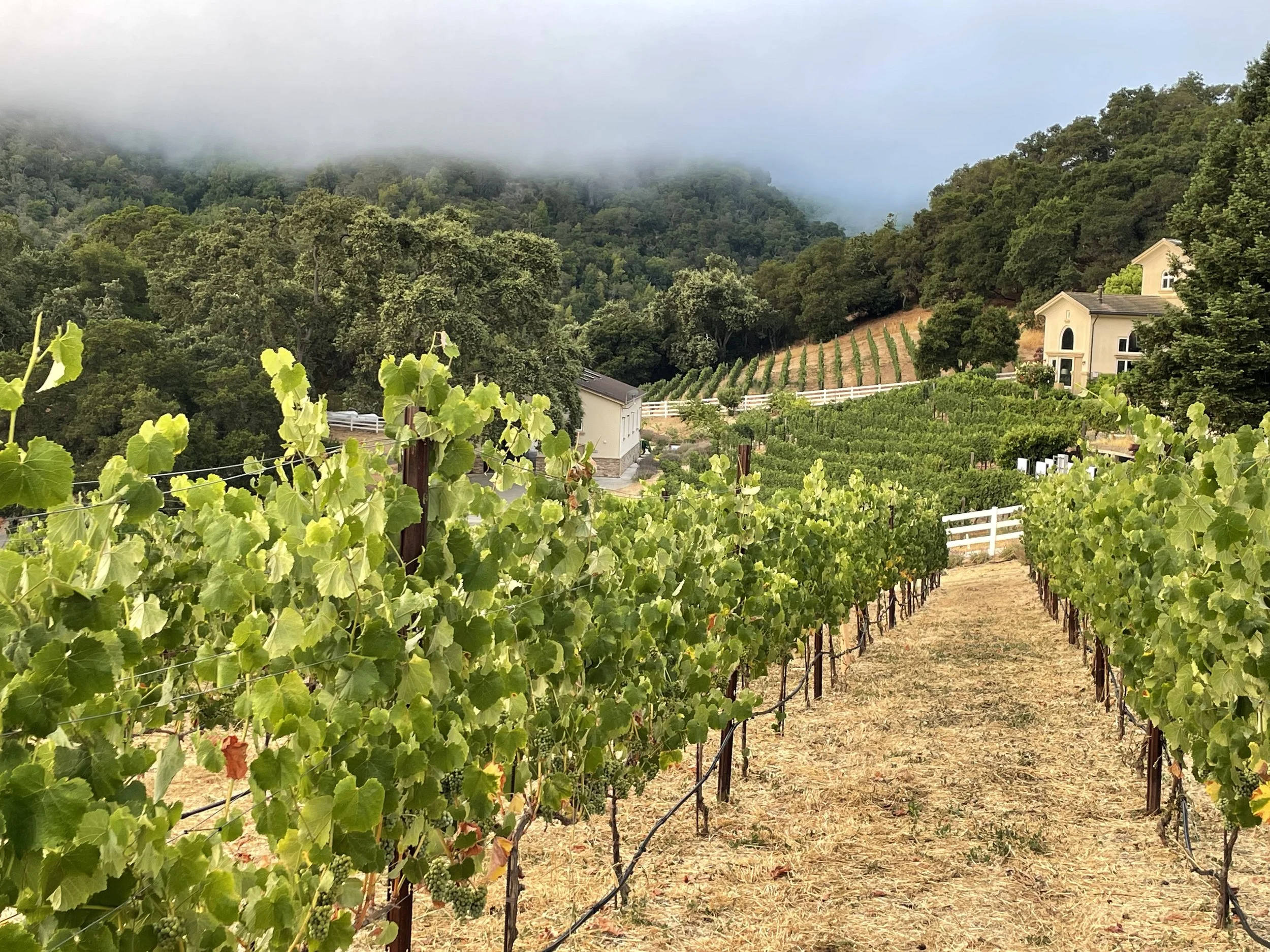Passion
There’s a lot of talk in the wine industry that it is full of passion, romance, art, etc. Kind of…
Yah, that’s blood. To protect the guilty we won’t name names, but they made the Grape Hook Hall of Shame list for 2025. Blood and wine baby. That’s passion! Funny how a vineyard accident makes a great blog post. I’m told that we need to post this image on instagram. I’m not on the “gram” and the marketing department doesn’t really like the idea of this picture on the account. Oh well. So I snuck it into the blog. Notice a few of the deflated berries… that’s bird damage.
There’s a lot of wine marketing talk of passion, romance, art, etc. It’s actually a lot of hard work and chemistry. The romance, passion, and art just sounds a lot better. It’s like passion is a fancy word to justify a slightly unhelathy addiction to crafting something that is economically challenging.
Yours truly doing punchdowns on the Primitivo that we harvested several weeks ago.
Heather using a hydrometer to test the remaining sugar during fermentation of our forthcoming Rosé of Primitivo. We have not come up with a name for it yet. Feel free to share your suggestions!
We took a little breather after the last harvest and went to a small rodeo in the east foothills of San Jose. The event was put on by an organization called Bridal Up Hope. They teach young girls confidence and responsibility by caring for and riding horses. We had donated some of our wine to the fundraising and celebration event.and it was a joy to see these girls show off their equine prowess.
Hats off to all of the volunteers who dedicate so much time to this program. That’s sacrificial living! So impressed.
The color guard presenting the flag prior to the start of the activities.
Completing The Harvest
Relief after beating the weather…
We finished up the 2025 season with two harvests of Cabernet Sauvignon on back to back Sundays.
As in years prior, the upper blocks of Cabernet Sauvignon tend to ripen a bit faster than the lower blocks. In this case, the upper blocks were ready for the pick on October 5th. The taste of the fruit and the sugar content of the grapes were in agreement with each other and confirmed the decision on the day to pick. Volunteers showed up in the early hours and we were picking by 7am.
An overcast early morning helped keep both grapes and harvest crew cool. By the time the pick was nearing completion, we were all feeling the fatigue of harvesting by hand and the sun eventually broke through for some gorgeous weather to finish the pick by. The two upper blocks of Cabernet Sauvignon yielded about three and there quarter tons of fruit which was a bit more than last year. As of the 12th, the fruit is already well into fermentation and our winemaker, Adam Comartin, is quite pleased with the quality of the fruit.
Harvesting Cabernet Sauvignon in Block Seven.
Bins full of Cab being kept cool out of the sun until it was time to process the fruit.
Beautiful clusters of Cabernet Sauvignon. The lighting in this picture gave the fruit a particular deep blue look. Don’t worry, those brown leaves get sorted out.
We had initially planned on a two week interval between the upper blocks of Cabernet being harvested (blocks 5 and7) and the lower blocks. Not that the lower blocks needed a full two weeks to finish ripening but rather to account for the logistics and relief for our volunteer harvest crew.
That didn’t happen.
The surprise threat of significant rain on October 13th forced our hand and we sent out the call for help for a pick on the 11th of October. We were so relieved that we had a strong turnout of friends and family and we picked a bit under three tons of fruit. For context, a ton of grapes makes about six hundred bottles of wine.
It was a blessing to have a cool morning to start the pick of block 3. While the clouds were picturesque, they were a bit of a foreshadow of things to come.
Beautiful clusters of Cabernet Sauvignon ready for harvest!
We were relieved to have completed the 2025 harvest just in time. We had debated as to whether to pick the fruit prior to or after the rains of October 13th but we were glad we got it ahead of time given the amount of rain we had. The pressure wasn’t that the fruit would absorb too much water but rather that we would not have enough of a breeze combined with sunny days afterwards to dry out the fruit and ensure that we wouldn’t experience bunch rot which could compromise the entire harvest.
We’re so grateful for all of the help with harvest both from family and friends but also to our professional support of Alesia Vineyard Management and our winemaker, Adam Comartin. We couldn’t do this without help from all of you! Let us know if you would like to participate in harvest next year!
Bring on the night… and the Primitivo!
The Puglian varietal gets its name from being one of the first red wine grapes ready for harvest.
Normally I wouldn’t be too happy about the alarm going off at 4am… but not today. It was Primitivo time and the picking crew arrived at 5am. Fortunately, Heather and I were able to catch an earlier standby flight home yesterday which allowed a few hours of daylight to wash out macro bins, position them in the field, and get ready for the first red wine grape harvest of the 2025.
Here comes the Primitivo!
It was dark when we started and headlamps were standard issue. The picking crew was fast and efficient and I didn’t want to get in the way. They had their system.
Instead I hovered over the bins worrying about whether it was going to rain or not. I distracted myself from the worry by picking out any MOG (Material Other than Grapes). The crew was picking clean but even the best crew needs some help with a sort. Mostly, the MOG consists of leaves or dried tendrils that get interwoven with a grape cluster. There’s the occasional “pincher bug” from time to time but everything get’s removed except grape clusters.
Grapes going into the bin. This year I used the tractor to take the bins down to the trailer… seemed a little safer and more efficient versus pulling the trailer down hill with 3,000lbs of grapes on it. I just get real nervous with any sort of side slope on the tractor but even more so when pulling all that precious cargo. If you have had our Primitivo, you know what a tragedy it would be to lose the grapes to an accident.
As the pick neared completion the sun was greeting us, however, a low cloud cover provided cooler temperatures for the pick which was a blessing. Cool grapes make happy wine. You don’t want to bring those grapes in hot.
Yours truly safely down the hill and getting ready to load the bin onto the trailer. At this point it is 7am and Heather snapped this photo as she was headed off to work. She was bummed that she couldn’t participate.
Unlike the white wine grapes that went immediately to press, the red varietals take a different path. The grapes will be de-stemmed and then go through fermentation. The whole time they will be in contact with the skins, seeds, and remaining stems. The time with skin contact will impart different flavors as well as give the wine a dark ruby color.
Jesus strapping down the bins in preparation to transport to the processing facility. These four bins came in at about 1.5 tons.
Grapes going up the elevator into the de-stemmer. The green chute on the right of the de-stemmer guides all of the stems. The fruit drops below into the 4’ tall macro bin where it will be inoculated with yeast and fermentation will begin.
White Wine Grape Harvest
Reacting fast to Sauvignon Blanc and Albariño.
The white wine grapes were harvested Monday September 7th. The alarm went off at 4:30am and it was time to get going. Coffee made, dogs fed, tractor warmed up and here we go. For 2025 we picked the Sauvignon Blanc and Albariño in the cool of the morning on a Monday. Since this was a busy work day for everyone and these grapes experienced an accelerated ripening, we had to be nimble and react quickly with the harvest. These grapes just didn’t give us the time to plan the communal pick that we so enjoy.
About an hour after the start of harvest the sun decided to get out of bed and join the activity. Heather was able to help for about an hour before she had to leave for work.
Bins of Albariño shortly after the pick. Each bin represents about 25 cases of wine. We harvested enough Albariño to make about 1,500 bottles or so. The smaller portion of Block Four produces about 300 bottles of Sauvignon Blanc.
I had hurt my back earlier in the week (weed whacking in the vineyard) so I wasn’t of much use during the harvest except to pick MOG (material other than grape) out of the bins as the crew dumped the harvest lugs into the bins. I could also drive the tractor to move the bins down the hill to the trailer as that didn’t require much of the back.
The Albariño all loaded up on the trailer for transport to the processing center.
Once the grapes arrived at the processing center, we went immediately to press. The grapes first take a ride up the elevator conveyor into the press. This allowed a second sort to remove any remaining MOG. The clean pick in the field significantly reduced the necessity of this secondary sort, but we do it anyways… the stray leaf in the press doesn’t exactly add to the flavor profile of good wine.
Beautiful Albariño grapes taking the ride of their life!
Once the grapes are in the press, the juice is immediately transferred to a holding tank where it is chilled down to allow for a more controlled fermentation. Lab work confirmed the timing was right and we were pleased with the numbers: The Sauvignon Blanc came it a little high at 24.5 Brix but the the acidity was nice at 3.46 and 4.7g/L TA. We will likely add a little bit of acidity to the Sauvignon Blanc as it was a bit riper than the Albariño and we want to preserve that fresh acidity the varietal is known for. The winemaker knows best!
The Albariño reported 21.6 Brix with 3.48ph and 5.1 g/L TA.
Overall we were pleasantly surprised with the numbers and yield from this block of the vineyard. We had feared we would have reduced yields this year due to growing challenges and winds during flowering, but we ended up with similar quantities as last year.
We were also paying close attention to the weather as two days after the pick we had rain… yikes! We dodged a bullet with the weather this year.
These wines will be ready to bottle in April/May of 2026.
A sunrise test.
On the hill early before the sun showed its face.
Nothing says Labor Day like, well, labor. The August heat has pushed the ripening of the fruit and it’s time to start paying close attention. We got up early to take grape samples from all the blocks. It is best to do this while the grapes are cool for a more accurate reading of the sugar content of the grapes.
Samples from each block collected. Next the grapes will be crushed in the bags and the juice extracted for measuring BRIX.
After the fruit is collected and crushed, the juice is extracted and a refractometer is used to measure the sugar content in the fruit. A taste of the juice is a nice reward for tromping all over the vineyard and walking through the countless spider webs between rows. I could do without that. I tell myself each year to just wave a stick in front of me while I walk but I always forget. Maybe next year.
The extracted juice.
Notice the juice from the older vine Cabernet Sauvignon (blocks one through three) are lighter in color than the younger Cabernet vines from the upper blocks (five and seven). It’s like grey hair I suppose.
That green Albariño juice will become a beautiful light golden color by the time it is done with vinification. The red wine grapes (Cabernet Sauvignon and Primitivo) are still several weeks away from being ready.
The Albariño, however, came in at 21.3 BRIX so we’ll plan on harvesting it early next week. When tasting the Albariño it was reassuring to taste the acidity that the varietal is known for.
The Sauvignon Blanc will also be ready, but this year we are not sure we will have enough fruit from the Sauvignon Blanc to produce wine. Time will tell.
Getting ready…
After the manicure.
There’s a certain combination of excitement and anxiety that comes in August. As we are in the home stretch to starting the harvests, we’re excited for what harvest will bring but anxious for how the fruit will turn out. It’s also a lot of work.
Most of the time is spent touching up the vineyard floor with the weed whacker. It sounds simple but five to six hours in the heat and dust while standing on a side slope does impart a certain “feeling” to the lower back and legs that I would be fine doing without. “Can’t you just run the tractor to do all that?” Yes and no. While the tractor would mow the middle of the vineyard rows quite well, at this time of year I prefer keeping the dust down (off of the fruit) as we approach harvest. Also, careful dressing of weeds around the trunks of the vines provides a nice clean look that satisfies the soul.
Next will be cleaning harvest lugs, macro bins, and preparing harvesting tools as they have been sitting for nearly a year.
Late August and early September brings a new routine to the mornings on the Farm. For the next six to eight weeks we will take random and dispersed samples of fruit from the various blocks to measure the sugar content in the grapes. The samples are taken in the cool of the early morning since the sugar content of a grape can vary throughout the day depending on temperature and other factors. The sugar content, along with taste, pip color, and other factors help guide us toward the optimal time to harvest. (that’s not a typo… grape seeds are commonly referred to as pips, not pits.)
The white wine grapes (Sauvignon Blanc and Albariño) will be first to harvest. Yesterday morning, coffee in hand, samples were taken from the vineyard and the Sauvignon Blan is reading 22.4 brix and the Albariño is at 18.6. We’ll see how the heat is over the next week. We’re anticipating a harvest in about two weeks, but time will tell. Yikes, so much to do!
It’s happening, again.
Véraison is in full swing. Even with our more temperate summer the vines are starting to change their wardrobe. The red wine grapes are changing color and the vine is shifiting what it does to the grapes, changing from making tartaric acid to accumulating sugars in the grapes. As the happens, the grapes are on their way to becoming tasty, not only for wine production but also for our avian friends. In past years we have not had much pressure from birds damaging the crops and we have historically only netted blocks one through three.
This year we are going to try bypassing nets all together. We will watch closely how much loss we might suffer from the birds and then as we continue to learn the nuances of the vineyards we can adjust accordingly next season.
Block six Primitivo grapes in véraison. You can see a little bit of shatter as well.
Notice the dried leaves on the ground. We typically leave most of the debris from leaf thinning, pruning, etc. on the vineyard floor to help maintain soil health with the incorporation of plant matter.
Staying Cool in the Summer
Cool mornings, dry ground, and lessons in the vineyard.
2025 is bringing a cooler summer so far. In the vineyard more often than not we are greeted with cool mornings and warm afternoons. Unless we have some serious heat in the next couple of weeks, we’re anticipating a later harvest this year than in 2024.
Overcast morning looking south from Block 6 (Primitivo).

